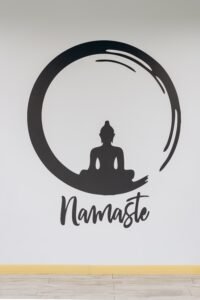
10-Minute Daily Routine: Craft a Yoga Practice for Beginners
Are you a beginner looking to incorporate yoga into your daily routine but don’t have much time to spare? Don’t worry, we’ve got you covered! In this blog post, we will guide you in crafting a 10-minute daily yoga routine that is perfect for beginners.
Yoga has numerous benefits for both the mind and body. It helps improve flexibility, strength, and balance while also reducing stress and promoting relaxation. By dedicating just 10 minutes each day to yoga, you can experience these benefits and start your day with a sense of calm and well-being.
Getting Started
Before we dive into the routine, it’s essential to create a calm and peaceful environment for your practice. Find a quiet space in your home where you can roll out your yoga mat or use a soft blanket as a substitute. Dim the lights, play some soothing music, and ensure that you won’t be disturbed during your practice.
Warm-Up
Here’s a simple and effective 5-minute warm-up routine:
- Neck Stretches: Begin by gently moving your neck in half circles, slowly dropping your ear towards your shoulder and then rolling it forward and down to the other side. Repeat this movement, allowing the neck muscles to loosen and release tension.
- Shoulder Rolls: Stand with feet shoulder-width apart. Slowly roll your shoulders backward in circular motions. After a few rotations, reverse the movement, rolling the shoulders forward. This helps release tension in the upper back and shoulders.
- Arm Circles: Extend your arms out to the sides at shoulder height. Make small, controlled circles with your arms, gradually increasing the circle size. Reverse the direction after a few circles. This warms up the shoulder joints.
- Side Stretches: Stand with feet hip-width apart. Reach one arm overhead, bending towards the opposite side, creating a gentle stretch along your side. Hold for a few seconds and then switch to the other side. This helps elongate the spine and warm up the torso.
- Forward Fold: From a standing position, slowly bend forward from the hips, allowing your upper body to hang. Let your arms dangle or grab opposite elbows for a gentle sway. This helps stretch the hamstrings and releases tension in the back.
Poses
Now that you’re warmed up, it’s time to move into the poses. Remember, as a beginner, it’s important to focus on proper alignment and listen to your body. If a pose feels too challenging, modify it or skip it altogether because the purpose of practicing Yoga is to be comfortable in the posture.
Here’s a quick 5-minute yoga routine that combines simple yet effective poses:
- Mountain Pose (Tadasana): Stand tall with feet together, arms at your sides. Inhale, lifting your arms overhead, palms facing each other. Engage your thighs and core, lengthen your spine, and hold for a few breaths.
- Forward Fold (Uttanasana): Exhale and fold forward from your hips. Let your head and arms hang, grabbing opposite elbows. Relax your neck and breathe deeply.
- Cat-Cow Stretch: Transition to the floor on your hands and knees. Inhale, arch your back, lifting your head and tailbone for Cow pose. Exhale, round your spine, tuck your chin to chest for Cat pose. Repeat these movements coordinating with your breath.
- Child’s Pose (Balasana): Sit back on your heels, extending your arms forward on the mat. Lower your forehead to the floor and relax in this resting pose, focusing on your breath.
- Seated Spinal Twist: Sit cross-legged, inhale, lengthen your spine, then exhale twisting to one side, placing one hand behind and the other hand on the opposite knee. Hold for a few breaths, then switch sides.
Finish your routine with the Child’s Pose (Balasana). Sit back on your heels and slowly lower your forehead to the mat. Extend your arms in front of you or rest them alongside your body. Take deep breaths in this pose, allowing yourself to relax and surrender.
What is Yoga (A Beginner’s Guide to Yoga)
Explore these recommended yoga products on Amazon to enhance your short yoga routine.
Luxurious Eco Suede Yoga Bolster for Restorative Yoga
Conclusion
By dedicating just 10 minutes each day to this simple yoga routine, you can experience the numerous benefits of yoga. Remember, consistency is key. Over time, you can gradually increase the duration of your practice and explore more advanced poses. Enjoy the journey and embrace the transformative power of yoga.
Startough – stay tough!